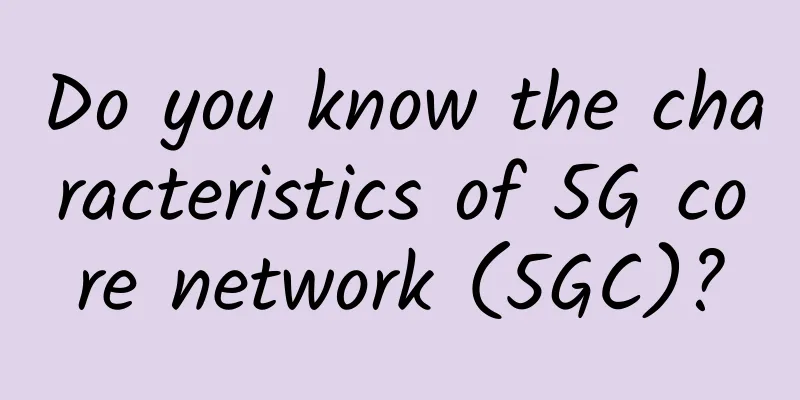Do you know the characteristics of 5G core network (5GC)?

|
3GPP defines the 5G core network as a decomposable network architecture, introducing a service-based interface (SBI) with HTTP/2 as the baseline communication protocol, and control plane and user plane separation (CUPS). This decomposition of 5G network function software, SBI, and CUPS are very supportive of cloud-native container-based implementations. 5GC network architecture (Source: Xianzao Classroom) Although 5G network functions can be built based on traditional architectures (such as virtual machine-based monolithic architectures), only when 5G network functions (NFs) are designed and implemented on a cloud-native container-based microservice architecture can real innovations be achieved in terms of flexibility, high scalability, elasticity, simplified operations, and lifecycle management. So what are the characteristics of the 5G core (5GC)? 1. Separation of control and user planes The 5G core network inherits the architecture of Control and User Plane Separation (CUPS) of 3GPP Release 14. In 4G EPC, S/PGW is decomposed into S/PGW-C and S/PGW-U, which independently provide efficient service extension. This decomposition continues to 5G, with the user plane function (UPF) playing a role only in packet processing for user traffic, while all other single-point processing is done by other control plane functions such as the session management function (SMF). The CUPS architecture in the 5G core brings the advantages of cost savings and scalability by centralizing the control plane function (SMF) and distributing the user plane function (UPF) to edge data centers. 2. Stateless Architecture 3GPP standards introduced a stateless architecture to enable network optimization and better reliability and resilience. Typically, a stateful network function/element must retain user information or contextual information associated with the transport layer, so when the function suddenly fails, this data must be preserved. Stateless architecture is a popular design pattern in modern microservices-based software architecture, which must use external data storage to decouple the application layer and data storage layer. To this end, 3GPP defines the Unstructured Data Storage Function (UDSF) in TS 21.195. 3. Service-Based Interface (SBI) The most significant change in the 5G core control plane is the introduction of a service-based interface (SBI) or service-based architecture (SBA) from the traditional point-to-point network architecture. With this new change, except for a few interfaces such as N2 and N4, almost every interface is now defined to use a unified interface, using the HTTP/2 protocol. This change makes the communication between NFs more like a service mesh function rather than a serial link, which helps reduce the dependencies between each interface and facilitates the independent scaling of each function, and also improves the agility of having new features and services across network functions.
4. Network Slicing DECOR and eDECOR have been introduced in LTE/4G. With the maturity of network function virtualization (NFV) and software defined network (SDN) technologies, the practical application of cloud-native network architecture in 5G core will increase rapidly. In 5G, network slicing is expected to enable enterprise customers to take advantage of networks that are "customized for specific customers or user characteristics" to meet every need for customizable network functions (such as speed, quality, latency, reliability, security and services). For network service providers, this will be a new opportunity to monetize network services. |
<<: What was the Internet like 20 years ago? Reminiscing about the Internet's heyday
Recommend
Speedtest releases Starlink network speed test report
Ookla, the parent company of the well-known speed...
Looking at the future from the perspective of performance, how will operators enter the second half of the 5G competition?
2021 is a big year for China's 5G development...
CDN network development trend: Accelerate the integration and innovative development with new technologies
In the process of development, CDN networks have ...
my country will promote 5G national standards in 2017 to speed up research and development and seize the right to speak in the industry
[[181162]] At the arrival of the new year, China&...
Why Cisco is making intent-based networking an open platform
The way businesses run their networks has remaine...
Will 5G kill Wi-Fi? The father of wireless data calls it a joke
With the official release of 5G commercial photog...
Compared with China Telecom and China Unicom, why is China Mobile's broadband so slow?
If you have been using China Telecom or China Uni...
30 pictures to explain HTTP, if you don't believe it, you still don't know it
During the interview process, HTTP is often asked...
The Importance of Layered Security in Edge Computing
In this article, we will introduce the role of in...
A new model for 5G smart factories
In the 5G era, smart factories will greatly impro...
Liu Biao, technical expert of the Information Accessibility Products Alliance: Using emerging technologies to reduce barriers to information access
[51CTO.com original article] When people use vari...
RabbitMQ communication model work model
Hello everyone, I am Zhibeijun. Today, I will lea...
CDN+MEC will become the main battlefield in the future
With the rapid development of cloud computing, cl...
BGPTO: Japan/Singapore CN2 GIA server $64/month, E3-1230v3/16GB/480G SSD/10-100M bandwidth
It's been a while since I shared information ...
China 6G: The next technological frontier!
China is promoting the application of informatiza...









